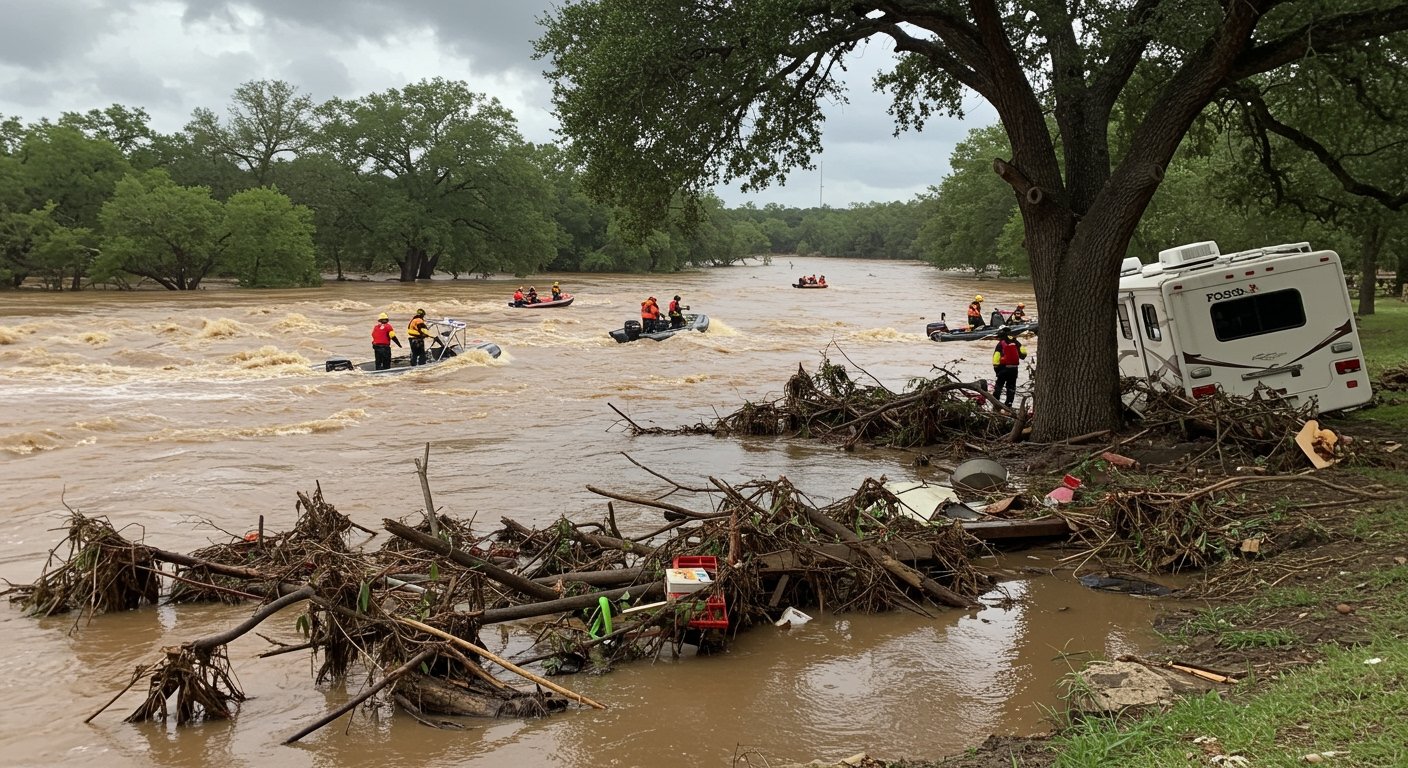Catastrophic Deluge Strikes Central Texas
A catastrophic flash flood event struck Central Texas with brutal force on Friday, July 4, 2025, transforming holiday weekend festivities into a scene of widespread devastation and tragedy. Torrential rains triggered an unprecedented surge in the Guadalupe River near Kerrville, leading to a disaster that has claimed the lives of at least 82 people, with scores, including children, still missing as of Sunday, July 6.
The suddenness and intensity of the flooding overwhelmed communities situated along the riverbanks. The Guadalupe River at Kerrville experienced a staggering rise of approximately 26 feet (8 meters) in a mere 45 minutes, beginning around 5 a.m. on Friday. This almost instantaneous wall of water left residents and visitors with little to no time to react, sweeping through populated areas with destructive power.
Holiday Weekend Turned Tragedy
The timing of the flood, coinciding with the busy Fourth of July holiday weekend, significantly exacerbated the human toll. Many of the affected areas, including summer camps and RV parks, were filled with holiday visitors seeking recreation along the river. An all-girls summer camp was particularly devastated by the rapid inundation. Numerous other camps and RV parks were also swept away or severely damaged, trapping occupants and contributing to the high number of casualties and missing persons.
Emergency responders faced immediate and immense challenges in conducting search and rescue operations amidst the fast-moving water and widespread destruction. The grim task of recovering bodies began as the floodwaters started to recede in some areas, revealing the scale of the catastrophe. The official death toll reached at least 82 by Sunday, July 6, a figure authorities warned could rise as search efforts continued for the scores still unaccounted for.
Preceding Rainfall and Ongoing Risk
The deadly flash flood was the direct result of significant rainfall that had saturated the region in the preceding hours and days. Reports indicated that some areas southwest of Bertram, Texas, and other nearby towns received over 20 inches of rain, overwhelming river systems and the ground’s capacity to absorb water.
The National Weather Service has maintained a vigilant posture, extending a flood watch for the affected areas into Monday evening, July 7. Officials warn that the ground remains heavily saturated, meaning any additional rainfall, even moderate amounts, will result in immediate runoff, posing a continued risk of flash flooding and further complicating recovery efforts.
Questions Raised Over Preparedness
In the aftermath of the disaster, questions are being raised by politicians regarding the preparedness and response of federal, state, and local officials. The rapid escalation of the flood and the high death toll have prompted calls for investigations into early warning systems, evacuation procedures, and infrastructure resilience. Critics argue that given Texas’ known vulnerability to extreme weather events, more should have been done to anticipate and mitigate the potential impact of such heavy rainfall, particularly during a busy holiday period.
The tragic events underscore the complex challenges faced by authorities in predicting and responding to the increasing frequency and intensity of extreme weather phenomena. While warnings were issued, the sheer speed and scale of the Guadalupe River surge proved catastrophic, highlighting potential gaps in rapid response capabilities for such sudden-onset disasters.
A Region Vulnerable to Extreme Weather
This deadly flood event serves as a stark and tragic reminder of Texas’ increasing vulnerability to extreme weather. Experts have consistently linked the rising frequency and intensity of such events, including torrential rainfall and flash floods, to broader climatic shifts. They point to warmer ocean temperatures and increased atmospheric moisture levels, phenomena fueled by global warming, as key factors contributing to more powerful storm systems capable of producing the unprecedented rainfall amounts witnessed in Central Texas.
The landscape of Texas, with its network of rivers and tributaries, is inherently susceptible to flooding, but the changing climate appears to be amplifying these risks. The events of July 4th, 2025, are likely to intensify ongoing discussions about climate resilience, urban planning, and the necessity of adapting infrastructure and emergency response strategies to cope with a future where extreme weather events may become the norm rather than the exception.
The Long Road to Recovery
As search operations continue and the full scope of the human loss becomes clearer, Central Texas communities face a long and arduous road to recovery. Beyond the immediate humanitarian crisis of finding the missing and caring for those displaced, the region faces immense challenges in rebuilding homes, infrastructure, and lives shattered by the floodwaters. The trauma inflicted by the disaster on survivors and emergency personnel is profound, underscoring the deep and lasting impact of such catastrophic events.
The tragedy along the Guadalupe River highlights the critical need for robust emergency management, effective public communication, and a proactive approach to addressing the risks posed by a changing climate. As Texas grapples with the immediate aftermath, the lessons learned from this devastating Fourth of July weekend will undoubtedly shape future policies and preparedness efforts in a state increasingly on the front lines of extreme weather.






